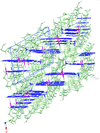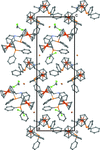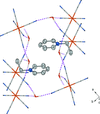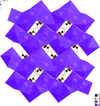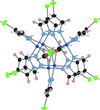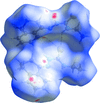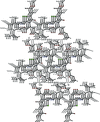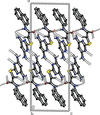issue contents
February 2017 issue

Cover illustration: Different crystallization conditions for the same reaction mixture led to two distinct terbium-tripodal alcohol complexes, viz. Tb(H3LEt)2(NO3)2](NO3)·0.5C4H10O2 and [Tb(NO3)(H3LEt)2(H2O)](NO3)2 (H3LEt = 1,1,1-tris(hydroxymethyl)propane, C6H14O3. See: Gregório, Giese, Nunes, Soares & Hughes [Acta Cryst. (2017). E73, 278-285].
research communications
Download citation


Download citation


The title compound was obtained from the condensation reaction of 3,5-di-tert-butyl-4-hydroxybenzaldehyde and 2,4-dinitrophenylhydrazine. The essential part (including all the non-hydrogen atoms except two methyl carbons) of the molecule lies on a mirror plane, which bisects the t-butyl groups.
CCDC reference: 1523249
Download citation


Download citation


The title compound was synthesized as a derivative of heptazethrene bearing two methyl and two tert-butylphenyl substituents, respectively, at the 1,9- and 7,15-positions. Albeit remotely located, the substituents contort the heptazethrene plane. The phenyl substituents stand approximately perpendicular to the core plane and prevent direct intermolecular contacts of the heptazethrene cores.
CCDC reference: 1523781
Download citation


Download citation


Two NiII compounds forming zigzag chain structures through O—H⋯N hydrogen bonds between dicarboxylic acids and NiII complexes were synthesized, and their structures were determined. They are co-crystals rather than salts.
Download citation


Download citation


The syntheses and crystal structures of 3-chloro-3-methyl-r-2,c-6-diphenylpiperidin-4-one and two of its derivatives are described. In each structure, the piperidine ring adopts a chair conformation. In the crystals, molecules are linked into C(6) chains by weak N—H⋯O hydrogen bonds and C—H⋯π interactions are also observed.
Download citation


Download citation


The title compound, C19H15N3O3, features an intramolecular O—H⋯N hydrogen bond and an E conformation for the Schiff base unit.
CCDC reference: 1524980
Download citation


Download citation


The title compound contains an oxolane ring, and six defined stereocentres and may serve as a useful synthon for the synthesis of calcitriol analogues. The configurations of the chiral C atoms of the side chain were unambiguously established in the refinement.
CCDC reference: 1522774
Download citation


Download citation


Macrocyclic 22,24,25-trimethyl-8,11,14-trioxa-25-azatetracyclo[19.3.1.02,7.015,20]pentacosa-2,4,6,15 (20),16,18-hexaen-23-one obtained by a Petrenko–Kritchenko condensation of 1,5-bis(2-formylphenoxy)-3-oxapentane, pentan-3-one and methylammonium acetate has been studied by X-ray structural analysis.
CCDC reference: 1524447
Download citation


Download citation


The title compound is an LiBr-bridged TiIV alkoxide dimer, supported by a novel monoanionic [NNN] pincer-type ligand. The bis[2-(1-imino-2,2-dimethylpropyl)-4-methylphenyl]amine ligand is the first reported ligand that bears hydrogen atoms on its ketimine side arms.
Download citation


Download citation


The title complex, [Ir(C27H29N5)(C10H8N2)Cl]2+·2CF3SO3−, was synthesized via the reaction of 2,6-bis(N-butylbenzimidazol-2′-yl)pyridine (bubzimpy) and 2,2′-bipyridine (bipy) with sodium hexachloroiridate(III) and precipitated by adding aqueous sodium trifluoromethanesulfonate solution. The compound was characterized using single-crystal X-ray diffraction, FT–IR, cyclic voltammetry/rotating disc electrode polarography, fluorescence spectrometry, high resolution mass spectrometry, CHN elemental analysis and 1H NMR.
CCDC reference: 1525487
Download citation


Download citation


The crystal structure of caesium dihydrogen citrate has been solved and refined using laboratory X-ray powder diffraction data, and optimized using density functional techniques.
Download citation


Download citation


The asymmetric unit of the title Schiff base contains three independent but conformationally similar molecules that are linked in the crystal through intermolecular N—H⋯N hydrogen bonds and C—H⋯π interactions, forming chains lying parallel to the c-axis direction.
CCDC reference: 1524849
Download citation


Download citation


Two mixed-valence compounds have been isolated from copper-cyanide-meen systems, Cu4(CN)5meen2 and Cu2(CN)3meen2·H2O, where meen is N-methylethylenediamine. The former crystallizes as a polymer, in which CuIImeen2 moieties are covalently linked via cyanide bridges to a three-dimensional CuI cyanide-bridged array, while the latter is a binuclear monomer.
Download citation


Download citation


The title compound, [Rb(2.2.2)-crypt]3RbSn9, contains Rb+ cations, partially coordinated by 2.2.2-cryptand molecules, and deltahedral nine-atomic tin cluster anions. The free Rb+ cations and the [Sn9]4– anions form strands extending parallel to [001].
CCDC reference: 1525634
Download citation


Download citation


The absolute structure of (R,R,SFc,SFc)-[Fe2(C5H5)2(C38H36BrNP2)]·Br·CH2Cl2 has been determined by X-ray single-crystal diffraction.
CCDC reference: 1524191
Download citation


Download citation


Wavy layers of molecules are formed in the crystal structure of 5-methylsalicylaldehyde due to weak C—H⋯O interactions between methyl groups and the aromatic ring system. Molecules form columns in which the methyl groups are oriented in opposite directions layer-by-layer along cell axis a. In the molecule, the hydroxyl substituent is bound intramolecularly to the aldehyde group at the ortho position.
CCDC reference: 1525796
Download citation


Download citation


The title compound has been crystallized in liquid ammonia as a reaction product of the reductive ammonolysis of the natural compound streptozocin. Elemental rubidium was used as reduction agent as it is soluble in liquid ammonia, forming a blue solution. Reductive bond cleavage in biogenic materials under kinetically controlled conditions offers a new approach to gain access to sustainably produced raw materials.
CCDC reference: 1524271
Download citation


Download citation


Two tetrachloridozincate salts of 4-carboxy-1H-imidazol-3-ium were structurally characterized. The first crystallizes with a water molecule of hydration and the second with a water of hydration and two equivalents of the zwitterion 4-carboxy-1H-imidazole per salt formula unit.
Download citation


Download citation


The molecule of 5-nitroisatin-3-phenylhydrazone deviates slightly from a planar geometry. In the crystal, molecules are linked by hydrogen bonding into a two-dimensional polymer along (120), forming rings of graph-set motifs  (8),
(8),  (26),
(26),  (32) and S(6). In addition, molecules are stacked along the [100] through C=O⋯Cg interactions, as suggested by the Hirshfeld surface, which also indicates that the most important contributions for the crystal structure cohesion are O⋯H (28.5%) and H⋯H (26.7%) interactions. An in silico evaluation of the title compound with the dihydrofolate reductase enzyme was performed and N—H⋯O and Cg⋯Cg interactions were found.
(32) and S(6). In addition, molecules are stacked along the [100] through C=O⋯Cg interactions, as suggested by the Hirshfeld surface, which also indicates that the most important contributions for the crystal structure cohesion are O⋯H (28.5%) and H⋯H (26.7%) interactions. An in silico evaluation of the title compound with the dihydrofolate reductase enzyme was performed and N—H⋯O and Cg⋯Cg interactions were found.
CCDC reference: 1524161
Download citation


Download citation


In the title compound, the 1,2,4-triazole ring is twisted with respect to the mean plane of quinoline moiety at 65.24 (4)°. In the crystal, molecules are linked by weak C—H⋯O and C—H⋯N hydrogen bonds.
CCDC reference: 1477670
Download citation


Download citation


In the title 1-oxo-1,2-dihydronaphthalene derivatives, the cyclohexa-1,3-diene rings of the 1,2-dihydronaphthalene ring systems adopt half-chair, boat and half-chair conformations, respectively. In the crystal of the methylphenyl compound, the molecules are linked via C—H⋯O, C—H⋯π and π–π interactions, forming a double-chain structure, while in the crystals of the other two compounds, molecules are linked by π–π interactions, forming a chain structure.
Download citation


Download citation


The title compound crystallizes in the monoclinic space group P21, with four crystallographically independent molecules, having a very similar conformation, in the asymmetric unit. The cluster of independent molecules has approximate non-crystallographic C2 point symmetry.
CCDC reference: 1526562
Download citation


Download citation


The redetermined structure of NaK5Cl2(S2O6)2 shows a super-cell, which accommodates subtle changes in the orientation of the O atoms of the dithionate groups compared to the previously reported structure.
CCDC reference: 1526611
Download citation


Download citation


The NiII cation is coordinated by three N atoms of three different 1,3,5-tris(imidazol-1-ylmethyl)benzene ligands, one O atom of an ethane-1,2-diol molecule, by a sulfate anion and a water molecule, forming a distorted octahedral NiN3O3 coordination geometry. The tripodal 1,3,5-tris(imidazol-1-ylmethyl)benzene ligands link the NiII cations to generate a metal–organic chain running along [100].
CCDC reference: 1470095
Download citation


Download citation


Copper is known for its variable coordination geometry adopted for different ligands. Here we report the crystal structure of a new imidazo[1,2-a]pyridin-1-ium tetrachloridocuprate(II) salt with a distorted tetrahedral geometry for the copper atom.
CCDC reference: 1526513
Download citation


Download citation


The title compound, Rb2O2·2NH3, has been obtained as a reaction product of rubidium metal dissolved in liquid ammonia and glucuronic acid. As a result of the low-temperature crystallization, a disolvate was formed. The peroxide bond length is 1.530 (11) Å
CCDC reference: 1526250
Download citation


Download citation


p-Arsanilic acid forms an isotypic set of three compounds with the alkali metals K, Rb and Cs, in which the primary layered coordination polymeric structures have similar asymmetric units comprising two independent and different metal cations and a bridging water molecule which lie within crystallographic mirror planes parallel to (100). The layers are linked across [100] through amine N—H⋯O hydrogen bonds to arsonate and water O-atom acceptors, giving overall three-dimensional network structures.
Download citation


Download citation


The title compound exhibits a polymeric structure caused by long Cu⋯O interactions, which lead to the formation of chains parallel to [100]. In the crystal, the chains are arranged in a distorted hexagonal rod packing.
CCDC reference: 1520352
Download citation


Download citation


An octahedral fac-C3NS2 coordination geometry is found for the ReI atom in the title compound; the dithiocarbamate ligand forms symmetric Re—S bonds. In the crystal, supramolecular layers are formed via weak C—H⋯O interactions.
CCDC reference: 1527565
Download citation


Download citation


The crystal structure of the title compound comprises a segregated columnar structure of cations and anions extending parallel to the b axis
CCDC reference: 1527928
Download citation


Download citation


(E)-4-Hydroxy-6-methyl-3-{1-[2-(4-nitrophenyl)hydrazinylidene]ethyl}-2-H-pyran-2-one has been synthesized and characterized by single-crystal X-ray diffraction and by using FT–IR, 1H and 13C NMR and UV–Vis spectroscopic techniques.
CCDC reference: 1515036
Download citation


Download citation


The crystal structure of trirubidium citrate monohydrate has been solved and refined using laboratory X-ray powder diffraction data, and optimized using density functional techniques.
Download citation


Download citation


The crystal structure of dicesium hydrogen citrate has been solved using laboratory X-ray single-crystal diffraction data, refined using laboratory powder data, and optimized using density functional techniques.
Download citation


Download citation


Two independent copper(II) cations with coordination numbers of 4 and 6 are bridged by dianionic salicylate anions into chains extending parallel [001]. O—H⋯O hydrogen-bonding interactions involving both the coordinating and the lattice water molecules result in the formation of a three-dimensional network.
CCDC reference: 1528159
Download citation


Download citation


A new arsenate K1 + 2xNi1 - xFe2(AsO4)3 (x = 1/8) was synthesized using a flux method and its crystal structure was determined from single-crystal X-ray diffraction data. It appears closely related to the α-CrPO4 structure type. The proposed structural model was validated by bond-valence-sum calculations, charge-distribution and Madelung energy analyses
CCDC reference: 1528356
Download citation


Download citation


A new centrosymmetric chloride-bridged CuII dimeric anion, in which one carboxyl group of the pyridine-2,4-dicarboxylic acid ligand remains protonated, is present in the title structure, together with a diprotonated piperazine as a charge-compensating agent.
CCDC reference: 1497751
Download citation


Download citation


The crystal structure of trirubidium citrate has been solved and refined using laboratory X-ray powder diffraction data, and optimized using density functional techniques.
Download citation


Download citation


The title nitropyrrole-based compounds are intermediates used in the synthesis of modified DNA minor-groove binders. They are ethyl 4-nitro-1H-pyrrole-2-carboxylate, its derivative ethyl 4-nitro-1-(4-pentynyl)-1H-pyrrole-2-carboxylate, N-[3-(dimethylamino)propyl]-1-isopentyl-4-nitro-1H-pyrrole-2-carboxamide and 1-(3-azidopropyl)-4-(1-methyl-4-nitro-1H-pyrrole-2-carboxamido)-N-[2-(morpholin-4-yl)ethyl]-1H-pyrrole-2-carboxamide.
Download citation


Download citation


A skew trapezoidal bipyramidal coordination geometry based on a C2S4 donor set is found in the structure of (C6H5)2Sn[S2CN(Me)CH2CH2OMe]2, with the SnIV atom lying on a mirror plane.
CCDC reference: 1528948
Download citation


Download citation


The hexanuclear copper pyrazolato complex has a trigonal prismatic shape and contains an encapsulated chloride ligand.
CCDC reference: 1529271
Download citation


Download citation


Cyanide anions bridge FeII and AgI cations to form a two-dimensional polymeric compound.
CCDC reference: 1528660
Download citation


Download citation


A direct synthesis of monomeric IrCl(1,5-cod)2 (1,5-cod = cycloocta-1,5-diene) from IrCl3·3H2O and its crystal structure are presented. The molecule's shape is midway between square pyramidal and trigonal bipyramidal.
CCDC reference: 1527918
Download citation


Download citation


Two new mononuclear complexes of ten- and nine-coordinate terbium(III) were synthesized from Tb(NO3)3·5H2O and the tripodal alcohol 1,1,1-tris(hydroxymethyl)propane (H3LEt) to be employed as potential building blocks for heterometallic 3d–4f block metal aggregates.
Download citation


Download citation


The crystal structure of pentasodium hydrogen dicitrate has been solved and refined using synchrotron X-ray powder diffraction data, and optimized using density functional techniques.
Download citation


Download citation


There are two molecules in the asymmetric unit of the title compound, one of them being disordered over the methyl group. The molecules are linked by weak H⋯S interactions into chains with graph-set motifs C(4) along [100] and and  (10) rings. The Hirshfeld surface calculation suggests that the most important contribution for the crystal structure are the H⋯H interactions (64.20%).
(10) rings. The Hirshfeld surface calculation suggests that the most important contribution for the crystal structure are the H⋯H interactions (64.20%).
CCDC reference: 1529622
Download citation


Download citation


The crystal structure of the title compound, dimethyl 2-((2Z,5Z)-5-(2-methoxy-2-oxoethylidene)-2-{(E)-[2-methyl-5-(prop-1-en-2-yl)cyclohex-2-enylidene]hydrazinylidene}-4-oxothiazolidin-3-yl)fumarate displays a conformational disorder which inverts the configuration of the chiral C atom within the cyclohexylidene ring.
CCDC reference: 1529291
Download citation


Download citation


The two title compounds are pyrazine-2,3,5,6-tetracarboxamide derivatives. In the first crystal, molecules are linked by N—H⋯O and N—H⋯O hydrogen bonds, forming a two-dimensional network structure. In the second crystal, an N—H⋯N hydrogen bond links the molecules into a chain structure, while a further weak N—H⋯N hydrogen bond links the chains, forming a two-dimensional network structure.
Download citation


Download citation


The two title compounds are (diaminopyrimidin-2-yl)thioacetamide derivatives. In the first structure, the pyrimidine ring is inclined to the naphthalene ring system by 55.5 (1)°, while in the second, the pyrimidine ring is inclined to the benzene ring by 58.93 (8)°. In the crystals of both compounds, molecules are linked by pairs of N—H⋯N hydrogen bonds, forming inversion dimers with  (8) ring motifs.
(8) ring motifs.
Download citation


Download citation


The molecular structure of the title compounds may be visualized as two octahedral metal coordinated units, fused through μ-oxide bridges across symmetry centres, leading to edge-sharing dimers.


 journal menu
journal menu



















